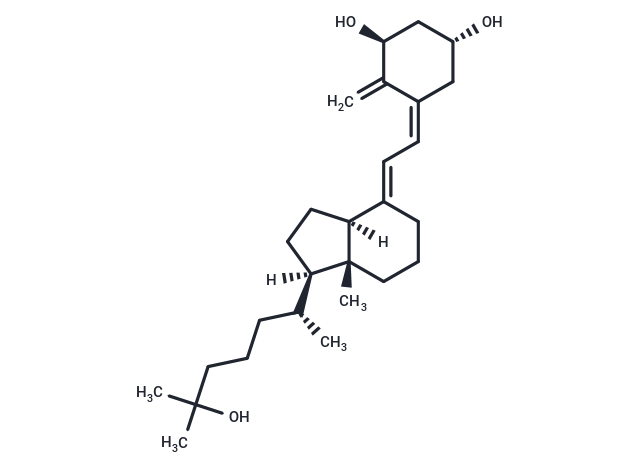Shopping Cart
- Remove All
 Your shopping cart is currently empty
Your shopping cart is currently empty
Calcitriol (1,25-Dihydroxyvitamin D3) is a metabolite of vitamin D and a vitamin D receptor (VDR) agonist (IC50=0.4 nM). Calcitriol increases intestinal absorption of calcium and phosphorus, and increases bone resorption with parathyroid hormone.

| Pack Size | Price | Availability | Quantity |
|---|---|---|---|
| 2 mg | $66 | In Stock | |
| 5 mg | $124 | In Stock | |
| 10 mg | $197 | In Stock | |
| 25 mg | $379 | In Stock | |
| 50 mg | $469 | In Stock | |
| 100 mg | $689 | In Stock | |
| 200 mg | $979 | In Stock |
| Description | Calcitriol (1,25-Dihydroxyvitamin D3) is a metabolite of vitamin D and a vitamin D receptor (VDR) agonist (IC50=0.4 nM). Calcitriol increases intestinal absorption of calcium and phosphorus, and increases bone resorption with parathyroid hormone. |
| Targets&IC50 | BT-474 cells:2.9 nM, SK-BR-3 cells:2.4 nM, C4-2 cells:13-23 µM, Vero cells:431.05 mg/ml, SUM-229PE cells:14 nM, B16-F10 cells:93.88 ppm (0.24 μM), LNCaP cells:13-23 µM, 267B-1 cells:30 μM |
| In vitro | METHODS: Malignant pleural mesothelioma cells MSTO-211H, REN and mesothelial cells MeT-5A were treated with Calcitriol (1-100 nM) for 24 h. Cell viability was detected by MTT Assay. RESULTS: Calcitriol treatment resulted in a dose-dependent decrease in the viability of MSTO-211H and REN cells. The viability of non-malignant MeT-5A mesothelial cells treated with Calcitriol did not change. [1] METHODS: Human colorectal cancer cells HT29 and SW480 were treated with Calcitriol (100 nM) for 48 h, and the expression levels of target proteins were detected by Western Blot. RESULTS: Calcitriol increased the expression of E-cadherin, and decreased the expression of cyclin D1 and c-Myc, two downstream target genes of Wnt/β-catenin signaling in HT29 and SW480 cells. [2] |
| In vivo | METHODS: To study the effects on acute lung injury, Calcitriol (1.0 µg/kg) was administered intraperitoneally to CD-1 mice and LPS (1.0 mg/kg) was administered 1-48 h later. RESULTS: Calcitriol significantly attenuated LPS-induced inflammatory cell infiltration in the lungs, as well as the elevation of TNF-α and MIP-2 in serum and lung homogenate. [3] METHODS: To study its effects on atherosclerosis, Calcitriol (20-200 ng/mouse in carboxymethylcellulose) was administered by gavage to ApoE-/- mice twice weekly for twelve weeks. RESULTS: Oral administration of Calcitriol reduced atherosclerotic lesions, macrophage accumulation, and CD4(+) T-cell infiltration in aortic sinuses, and in Calcitriol-treated mice, there was a significant increase in Foxp3(+) regulatory T-cells in mesenteric lymph nodes, spleen, and atherosclerotic lesions and a decrease in CD80(+)CD86(+)DC), as well as a decrease in IL-10 and IL-12 mRNA. -10 and IL-12 mRNA expression was increased. [4] |
| Cell Research | Calcitriol is dissolved in DMSO and stored, and then diluted with appropriate medium before use[1]. Experiments are performed using parathyroid tissue slices instead of dispersed parathyroid cells so that tissue architecture is maintained. Parathyroid glands are cut into small pieces of approximately 1 mm3 and placed in individual wells (24 well dishes) with constant shaking at 37°C and placed in an incubator with a humid atmosphere. The incubation medium is buffered (pH 7.4) and contained 125 mM NaCl, 5.9 mM KCl, 0.5 mM MgCl2, 1 mM NaH2PO4, and Na2HPO4 (1:2 ratio), 1 mM Na-pyruvate, 4 mM glutamine, 12 mM glucose, and 25 mM HEPES. Insulin 0.1 IU/mL, bovine serum albumin 0.1%, penicillin G 100 IU/mL, and streptomycin 100 μg/mL are added to the medium. CaCl2 is added to achieve a final target ionized calcium concentration of 1.25 mM as measured with a selective electrode (634 Ca/pH analyzer). Ionized calcium concentration is also measured in each well after the completion of the experiment, and no change in the ionized calcium concentration is observed. Calcitriol is added to the medium to achieve concentrations ranging from 10-10 to 10-7 M. To quantify the amount of free Calcitriol, we filtered the medium through a membrane with a 5000-MW cutoff and Calcitriol is measured by RIA (Gamma 1,25-Dihydroxyvitamin D). As compared with total Calcitriol, the concentration of free Calcitriol is decreased by one order of magnitude[1]. |
| Synonyms | Topitriol, Rocaltrol, RO215535, Calcijex, 1,25-Dihydroxyvitamin D3 |
| Molecular Weight | 416.64 |
| Formula | C27H44O3 |
| Cas No. | 32222-06-3 |
| Smiles | C[C@@]12[C@](/C(=C/C=C/3\C(=C)[C@@H](O)C[C@H](O)C3)/CCC1)(CC[C@@]2([C@@H](CCCC(C)(C)O)C)[H])[H] |
| Relative Density. | 1.0362 g/cm3 (Estimated) |
| Storage | keep away from direct sunlight,store under nitrogen | Powder: -20°C for 3 years | Shipping with blue ice/Shipping at ambient temperature. | |||||||||||||||||||||||||||||||||||
| Solubility Information | Ethanol: 77 mg/mL (184.81 mM), Sonication is recommended. H2O: < 1 mg/mL (insoluble or slightly soluble) DMSO: 55 mg/mL (132.01 mM), The compound is unstable in solution, please use soon. | |||||||||||||||||||||||||||||||||||
Solution Preparation Table | ||||||||||||||||||||||||||||||||||||
DMSO/Ethanol
| ||||||||||||||||||||||||||||||||||||

Copyright © 2015-2025 TargetMol Chemicals Inc. All Rights Reserved.